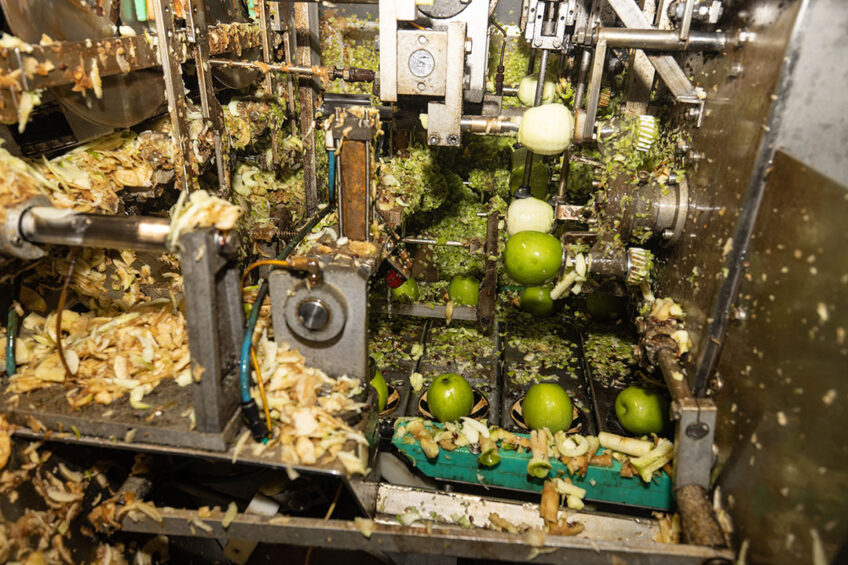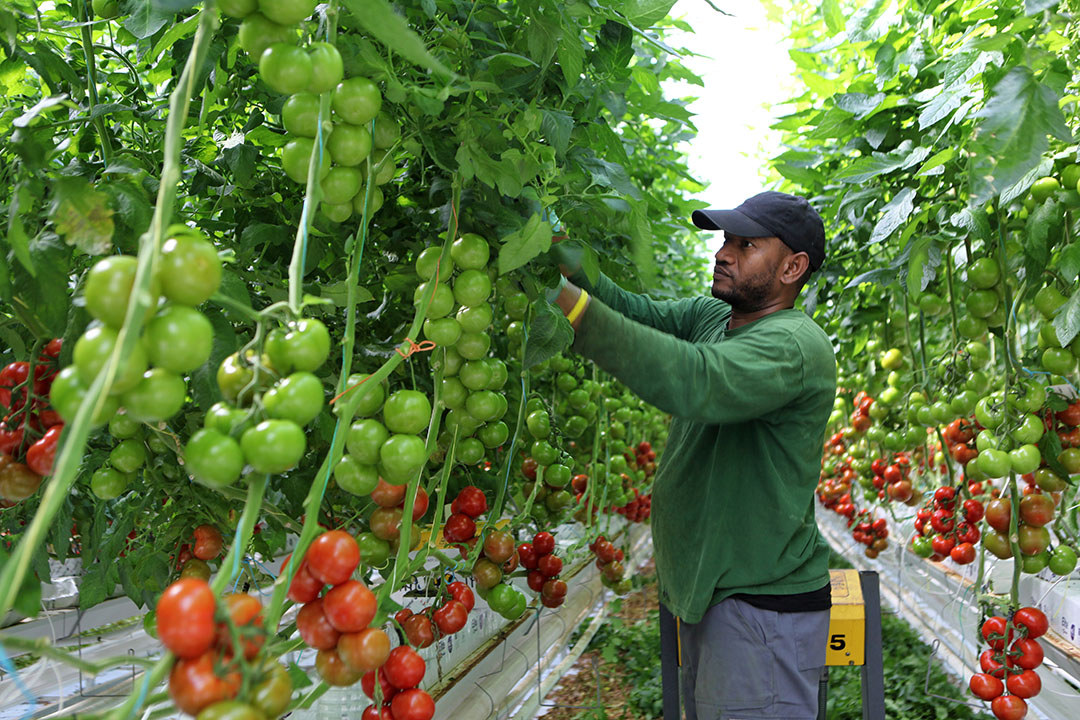Fruit and vegetable products in poultry feeding

Incorporating fruit and vegetable processing waste into poultry feed could help alleviate the problem of scarcity of feed supply in many parts of the world. From a sustainability point of view, as an alternative to its disposal as waste, it could also help reduce pollution.
In the processing of fruits and vegetables for human consumption, large volumes of waste products are left over. It is not uncommon for much of this waste to end up in landfills, disregarding its potential. This article will look at the waste products, their nutritional value and their potential as poultry feed ingredients, sometimes straight from the food process but more often after the application of a feed processing technique, such as drying, grinding and mixing.
Apple pomace
Apple pomace is typically tossed away in landfills, although it can be used as a valuable feed source in poultry diets at 5-10% to achieve high productivity. This product contains high concentrations of carbohydrates, minerals, dietary fibre and phytochemicals like phenolics (4.22-8.67 mg/g), total flavonoids (0.45-1.19 mg/g) and total flavan-3-ols (2.27-9.51 mg/g) with strong antioxidant properties.
It also comprises bioactive constituents, such as phytochemicals and prebiotics, that could help increase the young chicken’s transport system for amino acids, improve the bioavailability of iron, boost microbial populations in the large intestine and support the growth of potentially beneficial gut bacteria.
Mango pomace
Mango pomace typically consists of peel, seed kernels and residual pulp and can be incorporated in up to 20% of the diets of grower broiler chickens without affecting nutrient intake and growth. It is considered an excellent source of dietary fibre, vitamins E and C, enzymes, polyphenols, and carotenoids, all of which have a variety of functional and antioxidant properties. Further, mango pomace has been reported to increase anti-lipid peroxidation and reduce cholesterol levels, thereby providing health-beneficial effects to humans.
Rejected bananas
According to recent UN Food and Agriculture Organization (FAO) statistics, the annual world production of bananas is 41.9 million tonnes (mt), of which 12-15 mt of rejected bananas are available for livestock feed. For broiler chickens, dried bananas can replace up to 7.5% of maize throughout the feeding period. With more than 7.5% banana, however, there was a progressive and significant reduction in weight. Although the cost of the feed was reduced with increasing levels of banana, the feed cost per kg of the birds’ weight gain steadily increased.
Grape pomace
Grape pomace results from the extraction of the juice for winemaking and contains high levels of polyphenols and flavonols. It can be included at levels of up to 10% in broiler diets. This level of inclusion enhances intestinal morphology, antioxidation capacity and the PUFA content of breast muscle. Excessive use of grape pomace, however, should be avoided because of the high level of lignified cell wall fraction content and anti-nutritional factors, such as condensed tannins and phytic acid.
Dried figs
Dried figs could serve as a source of natural enzymes, such as cellulase, xylanase and glucanase. These enzymes can be useful in poorly digestible diets containing high levels of barley or other grains. The high viscosity of the gut contents with such diets reduces digestibility and utilisation.
A recent study was conducted to compare the performance of chicks fed diets supplemented with either artificial enzyme premixes or dried fig meal. Growth rate and feed efficiency increased by 7% and 12%, and mortality was reduced by 3% and 1.8%, respectively, when feeding the dried fig.
Pomegranates
Pomegranate pulp is generated during pomegranate juice extraction and comprises outer peel, seeds and residual pulp. It could be used as urea-treated pomegranate peel, fermented or in oil form. This by-product is rich in poly and monomeric phenols. Studies in broilers show that the incorporation of 1-2% pomegranate pulp results in beneficial effects on meat fatty acid levels and protein content in the breast, as well as reduced meat cholesterol and lipid oxidation values.
In other studies, the inclusion of 7-10% in the diet of heat-stressed broilers enhanced growth performance, blood cholesterol and antioxidant status. In laying hens, supplementation with 2-4% pomegranate peel powder improved blood antioxidant activity and reduced plasma cholesterol and triglyceride content.
Coconut
Coconuts can be formed into pellets or powders and incorporated into poultry diets as a major protein supplement (73% protein). It can then be used to replace 20% of the conventional protein sources, such as soybean meal, without any adverse effects on production. At higher levels, growth rate and feed efficiency will be reduced. This has been attributed to the fact that coconut protein is deficient in the amino acid lysine due to the heat treatment of the product during manufacture.

Tomato pomace
Tomato pomace can serve as a good source of protein for poultry and livestock. Chemical analysis of pomace indicates that the product contains around 20-25% crude protein, with 13% more lysine than soybean-meal protein. The product is also a good source of B vitamins and a fair source of vitamin A.
In addition, the amount of xanthophyll present in the pomace is high and comparable to that of corn gluten or alfalfa meal (about 200-240 mg/g). This is particularly important for laying hens, as it helps to improve egg yolk colour and quality.
The inclusion of tomato pomace in poultry diets also helps to prevent digestive problems. Chicks fed on pomace were, in some cases, less prone to diarrhoea or other digestive disorders. This could be attributed to the anti-oxidation property of pomace, which improves feed quality and hygiene. Tomato pomace should not be used in amounts exceeding 20% of the total rations for either broilers or layers. The high fibre content of pomace (30% crude fibre) can severely restrict the available energy content of the diet. Excessive feeding of pomace can also make diets unpalatable due to the bitterness of pomace. This is particularly true when the untreated material is included in the diet.
Olives
The value of olive pomace in poultry feeding has also been tested using material that has first been autoclaved for 1 hour at 120°C or pre-treated with different levels of NaOH, followed by inoculation of the pre-treated material with various biocatalysts for up to 10 days. The purpose was to de-lignify the material and make its ME content more biologically available. Results so far have been promising and the responses have been positive in terms of feed intake, growth and feed conversion. Further work is still needed to determine the economic and technical feasibility of adopting such a new poultry feeding programme under practical farm conditions.
Potato meal
In one study, potato meal was incorporated in rations of broiler and laying hens as a substitute for corn meal. There were no differences in feed conversion ratio, survivability rate and dressing percentage among the treatment groups of broilers with up to 30% replacement of corn by potato. Furthermore, no notable difference was observed in egg production and egg quality of laying hens on potato diets. These results suggest that potato meals of up to 30% could be included in both broiler and laying hen diets without any negative effects on production performance.
Carrots
Carrots contain 10% CP, 1.4% EE, up to 60% sugars, mostly sucrose (on a DM basis), and are a good source of vitamin C (300-700 mg/kg DM) and carotene. In one study, dried carrot meal included at 8% in the diet of laying hens significantly improved yolk colour when compared with a wheat-based control diet. This improvement was similar to that obtained with a yellow maize-based diet. Carrots also decreased pecking behaviour, thus improving the welfare of birds.
References are available on request.













